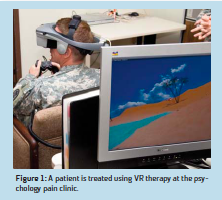By Melba C. Stetz et al.
The International Association for the Study of Pain (IASP) defines pain as, “an unpleasant sensory and emotional experience arising from actual or potential tissue damage or described in terms of such damage.” IASP and others recommend identifying pain with the help of the following categories/ axes: (1) anatomical location; (2) body system involved; (3) temporal characteristics; (4) intensity and time since onset; (5) etiology; and (6) neurochemical mechanism. Similarly, in the behavioral sciences, there have also been attempts to diagnose pain. Some of the diagnoses found in the Diagnostic and Statistical Manual of Mental Disorders (DSM) are: (1) psychogenic pain disorder; (2) somatoform pain disorder; and (3) pain disorder. Therefore, defining pain itself can be a “painful experience.”
In the United States, we have many war fighters supporting the longest fight in our history. Many of these war fighters, and their families, experience some type of pain. With this in mind, the Department of Psychology at the Tripler Army Medical Center has created the Pain Rehabilitation Program. This program provides comprehensive assessment and treatment for the complex interaction of physical, emotional, and social factors related to pain perception. This program’s mission is to provide warfighters, veterans, and military families with innovative, integrative, high quality, and multidisciplinary bio-psycho-social-spiritual clinical care. Specifically, it incorporates conventional, complementary, and alternative medicine to optimize military readiness, retention and overall wellness. Desired outcomes are to minimize pain, to maximize function and return patients to highly productive lives.

There is currently an active protocol called “A Comparison of Guided Imagery and Virtual Reality for the Treatment of Chronic Pain.” The proposed research investigates whether VR enhances the effectiveness of traditional imagery techniques, specifically somatic body imagery, to alter the perception of pain. Patients referred for chronic pain to the Pain Management Program at Tripler Army Medical Center will be recruited to participate in this study. Each volunteer will use an imagery technique in three modes: audio-tape guided imagery, therapist guided imagery (conventional treatment), and therapist guided imagery presented in a virtual environment. Each mode will be presented for one session. Outcome measures include a pre- and post-session rating of the intensity of pain, a self-efficacy rating scale to measure a patient’s perception of how helpful and effective they perceived the intervention technique, and biofeedback measures, consisting of muscle tension (EMG), temperature, and skin conductance (EDG). Equipment used includes the emagin headseat and “Shell City” VR environments (VRMC, San Diego). The study consists of three visits where the effectiveness of technology vs. face-to-face interaction with relax personnel is compared.
These studies will help to determine which method of pain treatment is the most effective and whether advanced technologies will be further employed to help the military deal with rehabilitation and injuries resulting in pain.
MAJ Melba C. Stetz, Ph.D. Raymond A. Folen, Ph.D. SGT Christopher A. Myers, H.S.D. Kathleen S. Brown, Ph.D. Tripler Army Medical Center U.S.A. Melba.Stetz@us.army.mil www.tamc.amedd.army.mil/offices/Psychology/research.html
About Brenda Wiederhold
President of Virtual Reality Medical Institute (VRMI) in Brussels, Belgium.
Executive VP Virtual Reality Medical Center (VRMC), based in San Diego and Los Angeles, California.
CEO of Interactive Media Institute a 501c3 non-profit
Clinical Instructor in Department of Psychiatry at UCSD
Founder of CyberPsychology, CyberTherapy, & Social Networking Conference
Visiting Professor at Catholic University Milan.







